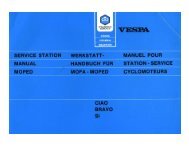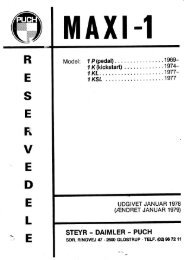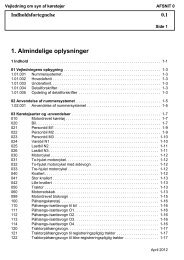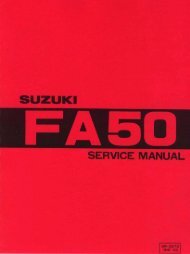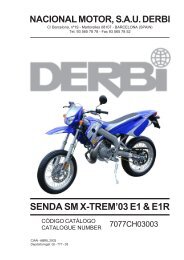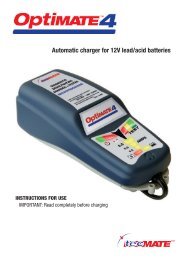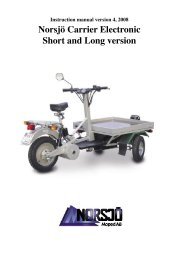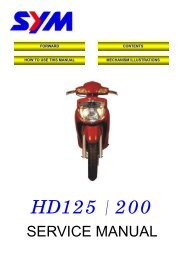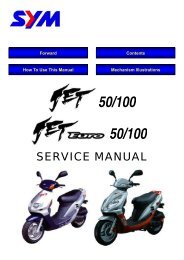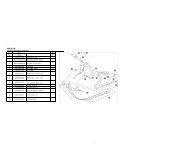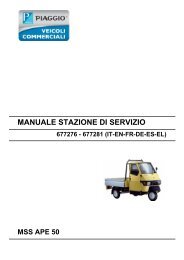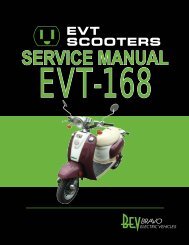Aprilia MA MY 50 Workshop manual - Scootergrisen
Aprilia MA MY 50 Workshop manual - Scootergrisen
Aprilia MA MY 50 Workshop manual - Scootergrisen
Create successful ePaper yourself
Turn your PDF publications into a flip-book with our unique Google optimized e-Paper software.
<strong>Workshop</strong> <strong>manual</strong><br />
<strong>MA</strong> <strong>50</strong><br />
<strong>MY</strong> <strong>50</strong><br />
977 X
Introduction<br />
The entire Introduction needs to be rewritten as follows:<br />
This <strong>manual</strong> contains information covering normal<br />
servicing procedures.<br />
The information and illustrations contained in this<br />
<strong>manual</strong> are current as of the <strong>manual</strong>’s publication.<br />
Since aprilia s.p.a. strives to always improve the<br />
quality and usefulness of its vehicles, changes may<br />
be made to the vehicles at any time. Thus, it is imperative<br />
that users of this <strong>manual</strong> understand that<br />
some information may be out of date for some vehicles.<br />
Be sure that the information in this <strong>manual</strong><br />
applies to the vehicle that you are servicing before<br />
you begin any service operations.<br />
This publication is intended for aprilia dealers and<br />
their trained and qualified mechanics. The description<br />
of many service and repair operations is intentionally<br />
omitted, as it is assumed that the users of<br />
this <strong>manual</strong> have basic mechanical training, basic<br />
knowledge of the procedures regarding motor vehicle<br />
repair, and have available to them all current information<br />
published by aprilia concerning the vehicle.<br />
Without these things, the repair or servicing of the<br />
vehicle could be affected and could lead to a dangerous<br />
condition or accident for the servicing mechanic<br />
or the operator.<br />
This <strong>manual</strong> does not describe all of the procedures<br />
necessary to repair and service the vehicle in detail.<br />
Therefore, it is important to be particularly careful in<br />
order to avoid any damage to the vehicle, its parts, or<br />
to cause injury to the mechanic or the rider.<br />
Changes in the technical specifications and servicing<br />
procedures that become necessary as a result of<br />
changes to aprilia vehicles will be documented and<br />
distributed to all aprilia dealers. Therefore, it is necessary<br />
that the latest aprilia information be kept available<br />
to the servicing mechanics.<br />
If you have questions regarding repair and servicing<br />
procedures, contact the aprilia Consumer Service<br />
(A.C.S.). A.C.S. technical counselors will be able to<br />
assist you with any problems that you might face.<br />
For further information refer to:<br />
- MOTORCYCLE VEHICLE WORKSHOP <strong>MA</strong>NUAL<br />
- ENGINE SPARE PARTS CATALOGUE<br />
- CHASSIS PARTS SPARE PARTS CATALOGUE<br />
aprilia s.p.a. reserves the right to modify any of its models in any<br />
manner at any time.<br />
This <strong>manual</strong> is protected by copyright in all countries. Reproduction<br />
by any means, print or electronic, is prohibited.<br />
The mention of products or services supplied by entities other than<br />
aprilia is made for information purposes only.<br />
aprilia is not responsible for the performance or use of any product<br />
not specifically recommended or endorsed by aprilia.<br />
LIST OF SECTIONS<br />
General information<br />
General specifications<br />
Cylinder-head-piston unit<br />
Carburetor - Reed valve set<br />
Oil pump - Starter motor<br />
Starter system - clutch<br />
Crankcase - Crankshaft<br />
First edition: January 2000<br />
Produced and printed by:<br />
C.L.D. s.r.l. Technical <strong>manual</strong>s division<br />
Via D. Alighieri, 37/A - Fornacette (PI)<br />
Tel. +39 (0)587 - 42280<br />
Fax +39 (0)587 - 422801<br />
www.cld.it<br />
E-mail: cld@cld.it<br />
on behalf of:<br />
aprilia s.p.a.<br />
Via G. Galilei, 1 - 30033 Noale (VE) - Italy<br />
Tel. +39 (0)41 - 5829111<br />
Fax +39 (0)41 - 441054<br />
www.aprilia.com<br />
www.serviceaprilia.com<br />
1<br />
2<br />
3<br />
4<br />
5<br />
6<br />
7
General information <strong>MA</strong><strong>50</strong> - <strong>MY</strong><strong>50</strong><br />
1-2<br />
CONTENTS<br />
Chapter 1<br />
Introduction ............................................................................................................................... 1-1<br />
CONTENTS ....................................................................................................................... 1-2, 1-3<br />
SAFETY WARNINGS................................................................................................................ 1-4<br />
<strong>MA</strong>INTENANCE WORK SAFETY PRECAUTIONS .................................................................. 1-4<br />
GENERAL SAFETY RULES ..................................................................................................... 1-5<br />
CARBON MONOXIDE .............................................................................................................. 1-5<br />
FUEL ......................................................................................................................................... 1-6<br />
GEARBOX OIL.......................................................................................................................... 1-6<br />
COOLANT ................................................................................................................................. 1-6<br />
Chapter 2<br />
Torque wrench settings ............................................................................................................. 2-2<br />
Lubricants table ......................................................................................................................... 2-2<br />
Service tools.............................................................................................................................. 2-3<br />
Chapter 3<br />
Cylinder head - remove ............................................................................................................. 3-2<br />
Thermostat - remove ................................................................................................................. 3-2<br />
Cylinder - remove ...................................................................................................................... 3-3<br />
Piston - remove ......................................................................................................................... 3-3<br />
Cylinder head - check ............................................................................................................... 3-3<br />
Cylinder - check ........................................................................................................................ 3-4<br />
Piston - check............................................................................................................................ 3-5<br />
Cylinder head-piston unit - refit ................................................................................................. 3-7<br />
Chapter 4<br />
Carburetor - remove .................................................................................................................. 4-2<br />
Reed valve set - remove ........................................................................................................... 4-2<br />
Reed valve set - check .............................................................................................................. 4-2<br />
Reed valve set - refit ................................................................................................................. 4-3<br />
Carburetor - refit ........................................................................................................................ 4-3<br />
Chapter 5<br />
Water pump - remove................................................................................................................ 5-2<br />
Flywheel magnet cover - remove .............................................................................................. 5-2<br />
Water pump - check .................................................................................................................. 5-2<br />
Water pump - refit...................................................................................................................... 5-3<br />
Release 00 2000-01<br />
ch. 1
General information <strong>MA</strong><strong>50</strong> - <strong>MY</strong><strong>50</strong><br />
Flywheel magnet - remove ....................................................................................................... 5-3<br />
Stator - remove ........................................................................................................................ 5-3<br />
Oil pump - remove.................................................................................................................... 5-4<br />
Oil pump - check ...................................................................................................................... 5-4<br />
Flywheel - check ...................................................................................................................... 5-5<br />
Stator - check ........................................................................................................................... 5-5<br />
Oil pump - refit.......................................................................................................................... 5-6<br />
Stator - refit .............................................................................................................................. 5-7<br />
Flywheel magnet - refit ............................................................................................................. 5-7<br />
Flywheel magnet cover - refit ................................................................................................... 5-7<br />
Starter motor - remove ............................................................................................................. 5-8<br />
Starter motor - refit ................................................................................................................... 5-8<br />
Water pump cover - refit ........................................................................................................... 5-8<br />
Chapter 6<br />
Starter system - remove ........................................................................................................... 6-2<br />
Starter system - check ............................................................................................................. 6-2<br />
Starter system - refit ................................................................................................................. 6-3<br />
Primary drive pulley - remove .................................................................................................. 6-3<br />
Primary drive pulley - inspection .............................................................................................. 6-4<br />
Starting clutch - remove ........................................................................................................... 6-5<br />
Starting clutch - check .............................................................................................................. 6-6<br />
Clutch and secondary pulley - remove ..................................................................................... 6-6<br />
Clutch - check .......................................................................................................................... 6-7<br />
Secondary pulley - check ......................................................................................................... 6-8<br />
Belt -check ............................................................................................................................... 6-8<br />
Gearbox - remove .................................................................................................................... 6-9<br />
Gearbox - check ....................................................................................................................... 6-9<br />
Gearbox - refit ........................................................................................................................ 6-10<br />
Secondary pulley - installation ............................................................................................... 6-11<br />
Clutch - reinstallation.............................................................................................................. 6-11<br />
Starting clutch - refit ............................................................................................................... 6-12<br />
Primary drive pulley - install ................................................................................................... 6-13<br />
Starter system - refit ............................................................................................................... 6-13<br />
Chapter 7<br />
Right hand crankcase and crankshaft - remove....................................................................... 7-2<br />
Crankshaft - Remove ............................................................................................................... 7-2<br />
Crankcase, crankshaft and connecting rod - check ................................................................. 7-2<br />
Bearings - refit .......................................................................................................................... 7-3<br />
Crankshaft - install ................................................................................................................... 7-4<br />
Crankcase - install.................................................................................................................... 7-4<br />
Crankshaft oil seal - refit .......................................................................................................... 7-6<br />
ch. 1<br />
Release 00 2000-01<br />
1-3<br />
1
General information <strong>MA</strong><strong>50</strong> - <strong>MY</strong><strong>50</strong><br />
SAFETY WARNINGS<br />
Throughout this <strong>manual</strong>, you will see the following symbols:<br />
WARNING<br />
: When you find this symbol on the vehicle or in the <strong>manual</strong>, it indicates that a potential for<br />
serious personal injury or death exists. Failure to follow this warning may result in serious risk of personal<br />
injury or death, of the mechanic working on the vehicle, the operator of the vehicle, or the general public. It<br />
also indicates that serious and permanent damage to the vehicle is possible.<br />
CAUTION : This statement indicates a potential hazard which may result in some personal injury, or<br />
damage to the vehicle.<br />
NOTE: The word “NOTE” in this <strong>manual</strong> precedes important information or instructions to which special<br />
attention must be given.<br />
1-4<br />
: liquid-cooled version only.<br />
<strong>MA</strong>INTENANCE WORK SAFETY PRECAUTIONS<br />
NOTE: always take the following precautions when repairing, fitting or refitting engine components.<br />
CAUTION : all maintenance and inspection work must be done with the engine turned off. Make sure<br />
that none of the parts are still hot (e.g. exhaust pipe, brakes or other parts subject to heating) after being<br />
removed from the motorcycle; if necessary, wait until they cool down. Place the engine on a suitable stand,<br />
making sure it is positioned on a solid, level work surface.<br />
WARNING : never use your mouth to hold engine parts, etc.: none of these items are edible and some of<br />
them are harmful, or even toxic.<br />
WARNING<br />
WARNING<br />
: do not start the engine in closed, poorly ventilated areas.<br />
: keep well away from heat sources. Do not use naked flames.<br />
NOTE: all persons carrying out servicing or repair work on the engine must be in possession of all the<br />
instructions and observe the safety specifications in all procedures (e.g. torque wrench settings). If two or<br />
more persons are working on an engine at the same time, make sure they observe the rules for their own<br />
safety and the safety of others.<br />
Use only GENUINE APRILIA SPARE PARTS<br />
Use only recommended lubricants (see Recommended Lubricants Table, p. 2-2).<br />
When a special tool is called for by this <strong>manual</strong>, you must use only the appropriate special tool. Do not attempt to<br />
perform operations which require special tools using any tool other than that specified in this <strong>manual</strong>.<br />
WARNING : Failure to obey the above instructions can result in serious personal injury, such as might<br />
occur when an improper wrench slips from a fastener, and your hand slams into the workbench.<br />
When tightening fasteners, start with the largest diameter fasteners. First apply enough torque to snug<br />
each of the largest diameter fasteners, working from the innermost fastener. Then, snug up other fasteners,<br />
working again from the innermost, and proceed diagonally. Tighten the fasteners to the required<br />
torque in the same order, then, check the torque on each of the fasteners, proceeding in the same order as<br />
above.<br />
WARNING : Do not use flammable solvents to clean parts. Use only fireproof solvents and detergents.<br />
Failure to obey this warning can lead to a fire with serious injury or even death.<br />
Always lubricate metallic parts and seals before reassembling.<br />
Release 00 2000-01<br />
ch. 1
General information <strong>MA</strong><strong>50</strong> - <strong>MY</strong><strong>50</strong><br />
CAUTION : Failure to follow this instruction can lead to seizure and premature part failure.<br />
When reassembling parts, be sure that they are fitted correctly. Some parts will physically fit in reversed or<br />
inverted position, and you will not know that they are incorrectly fit until after assembly is complete.<br />
CAUTION : Fitting parts incorrectly can lead to irreparable damage to the engine, as well as possible<br />
seizure or other engine malfunction.<br />
Never reuse gaskets, circlips, snap rings, O rings (OR) or split (cotter) pins.<br />
When installing a new snap ring, spread the ends apart no farther than necessary to slip it over the shaft.<br />
After the new snap ring is installed, make sure that it is firmly and fully seated in its groove. Note that there<br />
is a right way and a wrong way to fit the snap rings, the rounded edge of the snap ring must always bear<br />
the thrust load. (Sharp edge “outward”.)<br />
Lubricate bearings abundantly before installing.<br />
NOTE: Bearings must run freely with no chatter, unevenness or noise. If these conditions are not met,<br />
replace the bearings with new ones.<br />
Mark the positions on all connections (hoses, wires, etc.) clearly before disassembling them. Each part<br />
must be clearly identified for reassembly.<br />
Carefully clean all gasket surfaces before reassembling. Remove all traces of old gaskets and gasket<br />
cement.<br />
NOTE: Failure to obey this instruction will lead to a leaky motor.<br />
Never reuse oil seals nor gaskets. Apply a thin layer of grease to the edges of oil seals, and either grease<br />
or gasket cement, as appropriate, to gaskets before reassembling. Unless otherwise instructed by this<br />
<strong>manual</strong>, install oil seals and bearings so that the identifying marks or part numbers are visible when the<br />
seal or bearing is installed.<br />
NOTE: Unless otherwise specified, follow the disassembly procedures in reverse order to reassemble.<br />
WARNING : Failure to follow the above instructions can lead to many engine difficulties, including such<br />
serious and dangerous conditions as engine seizure or total failure. Such failure, if it occurs while the<br />
vehicle is being ridden, can lead to an upset, with subsequent serious injury or even death. If there is any<br />
doubt about your ability to properly carry out the operations described in this <strong>manual</strong>, seek assistance<br />
from your local <strong>Aprilia</strong> dealer or <strong>Aprilia</strong> Customer Service, or your factory service representative, as appropriate.<br />
Never attempt to perform any of the operations described in this <strong>manual</strong> unless you have the appropriate<br />
special tools, a clean well-lighted, well-ventilated work area, and knowledge necessary to carry these<br />
procedures out properly.<br />
GENERAL SAFETY RULES<br />
CARBON MONOXIDE<br />
Any maintenance jobs that have to be done with the engine running MUST be performed in a well-ventilated<br />
environment.<br />
WARNING<br />
: do not work in enclosed spaces without an exhaust gas extraction system. Exhaust gases<br />
contain carbon monoxide, a poisonous gas that may cause loss of consciousness and even death.<br />
ch. 1<br />
Release 00 2000-01<br />
1-5<br />
1
General information <strong>MA</strong><strong>50</strong> - <strong>MY</strong><strong>50</strong><br />
FUEL<br />
See the use and maintenance handbook supplied with the motorcycle for information on the type of fuel to use.<br />
WARNING : the fuel is highly inflammable and can be explosive in certain conditions. Always take great<br />
care when handling it.<br />
WARNING : fuel vapors can damage your health. Avoid inhaling them. Always make sure there is a<br />
suitable air exchange in rooms where exposed fuel is present.<br />
WARNING : do not smoke, create sparks, use naked flames or any other heat source that may cause<br />
fires or explosions in the vicinity of fuel stores or places where there are likely to be fuel vapors.<br />
CAUTION : do not let the fuel come into contact with the skin. Use protective gloves. Do not use your<br />
mouth on the tube when siphoning fuel, as you may inhale the vapors or fuel itself.<br />
CAUTION<br />
1-6<br />
: use authorized waste disposal methods when disposing of fuel.<br />
KEEP OUT OF REACH OF CHILDREN<br />
GEARBOX OIL<br />
Use F.C. SAE 75W - 90 oil or GEAR SYNTH oil. As an alternative to the recommended oil, you can<br />
use brand-named oils with performance specifications equivalent to or better than A.P.I. GL-4.<br />
CAUTION : insufficient lubrication or the use of unsuitable oils will cause increased wear on the moving<br />
parts and may lead to irreparable breakdowns.<br />
CAUTION<br />
: do not over-tighten the oil drain plug, as this may damage the engine crankcase.<br />
CAUTION : used oil contains environmentally harmful substances and must be disposed of in accordance<br />
with legal regulations.<br />
CAUTION : continuous and prolonged contact with oil can cause serious skin disorders. Always wash<br />
your hands thoroughly after handling oil.<br />
KEEP OUT OF REACH OF CHILDREN<br />
COOLANT<br />
The coolant is made up of <strong>50</strong>% distilled water and <strong>50</strong>% anti-freeze, this being the ideal mixture for most running<br />
temperatures, with effective anti-corrosion properties. Keep to the same mixture in the warmer seasons as well, as<br />
it evaporates more slowly and thus requires less topping up. This, in turn, will reduce the build-up of mineral salt<br />
deposits, thus helping to keep the cooling system working efficiently.<br />
Check the coolant circuit frequently at temperatures below 0°C (32°F). If necessary, increase the concentration of<br />
anti-freeze to no more than 60%.<br />
Use only anti-freeze and anti-corrosion fluids without nitrites, as this guarantees protection down to -35°C (-31°F).<br />
CAUTION : do not remove the filler cap when the engine is hot, as the coolant may squirt out under<br />
pressure and cause burns/scalds.<br />
CAUTION : some of the coolant components are inflammable and burn with an invisible flame, thus<br />
increasing the burns hazard.<br />
CAUTION<br />
: contact with the coolant can cause burns or skin irritations. If the coolant gets into your<br />
eyes, wash copiously with clean water and call a doctor immediately.<br />
WARNING : if swallowed, stimulate vomiting and call a doctor immediately. Even though it is highly<br />
toxic, coolant is particularly attractive to animals. Always keep coolant containers hermetically sealed to<br />
stop animals from drinking it.<br />
KEEP OUT OF REACH OF CHILDREN<br />
Release 00 2000-01<br />
ch. 1
General specifications<br />
8<br />
ch. 2<br />
9<br />
1<br />
2<br />
13<br />
3<br />
14<br />
6<br />
4<br />
7<br />
12<br />
5<br />
10<br />
11<br />
19<br />
Release 00 2000-01<br />
<strong>MA</strong><strong>50</strong> - <strong>MY</strong><strong>50</strong><br />
16 15<br />
18<br />
17<br />
2-1<br />
2
General specifications <strong>MA</strong><strong>50</strong> - <strong>MY</strong><strong>50</strong><br />
Torque wrench settings<br />
Pos. Description Qty. Type Torque wrench setting<br />
Nm ft-lb<br />
1 Water pump cover bolt 3 M5 x 0.8 7 5.163<br />
2 rh crankcase cover bolt 5 M6 x 1 7 5.163<br />
3 Stator nut 1 M10 x 1.25 38 28.029<br />
4 Stator bolt 3 M6 x 1 9 6.638<br />
5 Oil pump bolt 2 M5 x 0.8 4 2.9<strong>50</strong><br />
6 Oil seal support bolt 1 M6 x 1 10 7.376<br />
7 Crankcase bolt, flywheel side 6 M6 x 1 9 6.638<br />
8 Carburetor flange bolt 4 M6 x 1 8 5.901<br />
9 Starter motor bolt 2 M6 x 1 13 9.589<br />
10 Oil drain plug 1 M8 x 1.25 18 13.277<br />
11 Starting gear bolt 2 M6 x 1 9 6.638<br />
12 Gearbox cover screw 6 M6 x 1 12 8.851<br />
13 Clutch holder nut 1 M28 x 1 <strong>50</strong> 36.88<br />
14 Secondary pulley nut 1 M10 x 1 <strong>50</strong> 36.88<br />
15 Gearbox case cover screw 12 M6 x 1 12 8.851<br />
16 Primary drive pulley nut 1 M10 x 1.25 33 24.341<br />
17 Cylinder head nut 4 M7 x 1 10 7.376<br />
18 Spark plug 1 M14 x 1.25 20 14.752<br />
19 Thermostat bolt 2 M4 x 0.7 35 25.816<br />
2-2<br />
LUBRICANTS TABLE<br />
USE SPECIFICATIONS BRANDS SYMBOL<br />
Mixer oil * ISO-L-ETC++, A.P.I. TC++ GREEN HIT 2<br />
* As an alternative to the recommended oil, you can use brand-named oils with performance specifications equivalent to or<br />
better than those stated in the table.<br />
** As an alternative to the recommended product, you can use a brand-named grease for rolling-contact bearings with a<br />
useful temperature range of -30°C to +140°C (86°F to +140°F), dropping point 1<strong>50</strong>°C to 230°C (302°F to 446°F), high anticorrosion<br />
protection and good water and rust resistance properties.<br />
*** Use only anti-freeze and anti-corrosion fluids without nitrites, as this guarantees protection down to -35°C (-31°F).<br />
Release 00 2000-01<br />
CITY 2T<br />
Gearbox oil * A.P.I. GL-4 F.C. SAE 75W – 90<br />
Grease for joints,<br />
GEAR SYNTH<br />
pins and bearings ** AUTOGREASE MP<br />
GREASE 30<br />
Coolant *** ECOBLU –40°C<br />
COOL<br />
Loctite thread sealant LOCTITE 243<br />
Loctite liquid sealant LOCTITE 580<br />
ch. 2<br />
B<br />
M<br />
T<br />
C<br />
F
General specifications<br />
Service tools - Kit part N° 8201821<br />
8106698<br />
8140152<br />
8140234<br />
8106702<br />
8106703<br />
ch. 2<br />
Connecting rod<br />
extractor<br />
Crankshaft bearing<br />
extractor<br />
Complete crankshaft<br />
installation tool<br />
Flywheel spanner<br />
wrench<br />
Clutch removal<br />
wrench<br />
8106707<br />
8140259<br />
8140207<br />
8140208<br />
Release 00 2000-01<br />
<strong>MA</strong><strong>50</strong> - <strong>MY</strong><strong>50</strong><br />
Pulley locking<br />
tool<br />
Clutch spring tool<br />
Moryama flywheel<br />
extractor<br />
Ducati flywheel<br />
extractor<br />
2-3<br />
2
General specifications <strong>MA</strong><strong>50</strong> - <strong>MY</strong><strong>50</strong><br />
NOTES<br />
2-4<br />
Release 00 2000-01<br />
ch. 2
Cylinder-head-piston unit<br />
B<br />
ch. 3<br />
Release 00 2000-01<br />
M<br />
M<br />
<strong>MA</strong><strong>50</strong> - <strong>MY</strong><strong>50</strong><br />
3-1<br />
3
Cylinder-head-piston unit <strong>MA</strong><strong>50</strong> - <strong>MY</strong><strong>50</strong><br />
Cylinder head - remove<br />
CAUTION : Never attempt to work on the<br />
engine or any of its parts with tools not specifically<br />
designed for the task. Always use close<br />
fitting wrenches and drivers that are in good<br />
condition. If a special <strong>Aprilia</strong> tool is called for, do<br />
not attempt the operation without that special tool.<br />
Obviously, damage caused by the use of improper<br />
or poorly fitting tools is not covered by warranty.<br />
Before removing the motor, you can gain access<br />
to the cylinder head, cylinder, piston and reed<br />
valve by removing the exhaust pipe, air box and<br />
carburetor.<br />
Drain all the coolant.<br />
(This must be done only if the engine has not<br />
been removed from the motorcycle frame; if the<br />
engine has already been removed, it should have<br />
been done before the removal).<br />
CAUTION : Do not pollute drains or water<br />
courses when disposing of coolant. Use authorized<br />
waste disposal methods.<br />
Remove the spark plug and the two carburetor heating<br />
circuit tubes with their 4 clamps. Unscrew the 4<br />
flanged cylinder head nuts (1), slackening them half a<br />
turn each time. Remove the cylinder head.<br />
NOTE: Remove the cylinder head with its<br />
two ring seals (internal and external).<br />
Make a careful note of how the two<br />
carburetor heating circuit tubes are connected<br />
before removing them, in order to be able to refit<br />
them correctly.<br />
Thermostat - remove<br />
Unscrew the two screws (1) shown in the figure and<br />
remove the thermostat. Check the mechanical condition<br />
of the thermostat.<br />
NOTE: Check the two thermostat screws for<br />
corrosion and coolant fluid deposits before removing<br />
them. The screws are small, and will<br />
easily break if too much torque is applied. If<br />
corrosion or deposits are evident, use penetrating<br />
oil, and wait for the penetrating oil to work before<br />
attempting removal.<br />
3-2<br />
Release 00 2000-01<br />
1<br />
1<br />
ch. 3<br />
1<br />
1<br />
1
Cylinder-head-piston unit<br />
Cylinder - remove<br />
Remove the cylinder water union (1).<br />
Unscrew the two cover retaining screws (2) and<br />
remove the cover (3) from its seat.<br />
Remove the cylinder , holding the piston in position.<br />
Remove the cylinder bottom gasket.<br />
Piston - remove<br />
CAUTION : Close the opening in the crankcase<br />
with a clean rag before removing the piston pin<br />
circlip to stop the circlip from dropping inside the<br />
engine. Thoroughly deburr the circlip housing and<br />
the piston pin insertion hole area before removing<br />
the piston pin.<br />
Do not use a hammer for removing the piston pin.<br />
Remove the 2 circlips using circlip pliers. Gently push<br />
out the piston pin, and remove the piston. Remove the<br />
needle bearing from the connecting rod’ s small end.<br />
Cylinder head - check<br />
Check the condition of internal (1) and external<br />
(2) O-rings on the cylinder head.<br />
Remove the carbon deposits from the cylinder head<br />
using a rounded scraper . Use great care not to damage<br />
the spark plug threads. Also, be very careful not<br />
to damage the cylinder head itself. Ensure that all<br />
deposits have been removed from the combustion<br />
chamber , but do not get carried away . Traces of hard<br />
carbon in the combustion chamber itself will not cause<br />
any problems.<br />
ch. 3<br />
3<br />
2<br />
1<br />
Release 00 2000-01<br />
<strong>MA</strong><strong>50</strong> - <strong>MY</strong><strong>50</strong><br />
2<br />
1<br />
3-3<br />
3
Cylinder-head-piston unit<br />
We have already inspected the cylinder head combustion<br />
chamber , so we do not need to discuss this.<br />
Inspect the cylinder head for warping, using a surface<br />
plate or rigid straight edge and feeler gauge. The<br />
cylinder head must be flat within 0.03 mm (0.0012 in).<br />
If the cylinder head is out of level more than 0.03 mm<br />
(0.0012 in), lap it in, using 400-600 abrasive paper<br />
placed on a perfectly flat surface plate, until the entire<br />
gasket surface shows an even frosted looking surface.<br />
Work the cylinder head in a figure 8, as shown in the<br />
illustration, turning the head regularly in your hand to<br />
ensure a perfectly flat surface.<br />
Cylinder - check<br />
Carefully remove all carbon deposits from the inlet<br />
manifold, but, again, do not go overboard and remove<br />
any aluminum. A rounded scraper , or a fine abrasive<br />
flap wheel, is helpful in this operation.<br />
Inspect the cylinder liner , and the condition of the<br />
cylinder bore. Slight longitudinal scoring is acceptable,<br />
but any scores deeper than 0.01 mm (0.0004 in), and<br />
any sign of seizure whatsoever , calls for reconditioning<br />
or replacement of the cylinder . Carefully remove<br />
any carbon deposits which remain in the transfer ,<br />
inlet, or exhaust ports.<br />
3-4<br />
Release 00 2000-01<br />
ch. 3<br />
<strong>MA</strong><strong>50</strong> - <strong>MY</strong><strong>50</strong>
Cylinder-head-piston unit<br />
Using a bore gauge, check the diameter of the cylinder.<br />
Compare your measurements with the table<br />
below. If the measurements establish that the cylinder<br />
is out of tolerance, you must replace the cylinder along<br />
with the piston and rings (see Clearances Table).<br />
Standard Wear limit<br />
Cylinder<br />
diameter “C”<br />
39.99 to 40.01 mm<br />
(1.574 to 1.575 in)<br />
40.1 mm<br />
(1.579 in)<br />
Taper “T” * -- 0.05 mm<br />
(0.0019 in)<br />
Ovalization “R” ** -- 0.01 mm<br />
(0.0004 in)<br />
* where “T” is the result of the difference between T1 and T2.<br />
** where “R” is the result of the difference between the two rightangle<br />
measurements.<br />
Piston - check<br />
Remove the piston rings, being careful not to widen<br />
them more than necessary . To remove carbon deposits<br />
from the piston crown, use a slightly rounded<br />
scraper . To clean the piston ring lands, use a discarded<br />
piston ring, as shown in the illustration. Do not<br />
use silicon carbide abrasive paper on the piston crown<br />
or the lands. This will remove too much metal, and<br />
cause pieces of silicon carbide to be embedded in the<br />
piston which will quickly destroy the cylinder bore and<br />
cause corrosion of the piston.<br />
Inspect the piston skirt carefully . If you see hard<br />
carbon deposits, it is best to eliminate them by dipping<br />
the entire piston in a proprietary cleaner such as<br />
carburetor cleaner .<br />
WARNING : Cleaners capable of removing hard<br />
carbon are inevitably extremely hazardous to use.<br />
Their vapors can cause serious illness, and contact<br />
with the skin or eyes will cause immediate<br />
serious injury. Always use appropriate protective<br />
equipment, such as goggles, and gloves, and<br />
follow scrupulously the instructions and warnings<br />
on the container and package of the cleaner.<br />
If, after cleaning, the piston shows slight scoring on<br />
the skirts, this may be used by very light rubbing with<br />
a very fine flat stone.<br />
CAUTION<br />
: Do not get carried away. You can<br />
quickly ruin a perfectly serviceable piston by<br />
removing scores on the piston skirt. The very<br />
lightest rubbing is always sufficient. Never use a<br />
file, silicon carbide abrasives, or any abrasive<br />
coarser than 800 grit on a piston skirt.<br />
ch. 3<br />
Release 00 2000-01<br />
<strong>MA</strong><strong>50</strong> - <strong>MY</strong><strong>50</strong><br />
3-5<br />
3
Cylinder-head-piston unit <strong>MA</strong><strong>50</strong> - <strong>MY</strong><strong>50</strong><br />
Renew the piston if the scoring is too deep (see<br />
clearances table).<br />
Measure the piston diameter (D) with a micrometer ,<br />
taking the reading at 5 mm (0.197 in) from the bottom<br />
edge of the piston, as shown in the figure.<br />
Check the piston-cylinder clearances against the<br />
values in the table.<br />
Measure the piston ring side clearance with a thickness<br />
gauge.<br />
Side clearance: 0.03 to 0.056 mm (0.0012 to 0.002 in)<br />
Inspect the piston rings. Ensure that they are not<br />
damaged and are seating against the cylinder . Inspect<br />
the ring gap by placing the ring within the top of the<br />
cylinder as shown in the illustration, and using a feeler<br />
gauge. Use the piston skirt to squarely position the<br />
ring about 1/2 inch below the top of the cylinder .<br />
La misura rilevata deve essere compresa tra:<br />
0.15 to 0.35 mm (0.006 to 0.014 in)<br />
3-6<br />
Release 00 2000-01<br />
CLEARANCES TABLE mm (in)<br />
ENGINE TYPE<br />
<strong>MA</strong> SCOOTER<br />
(CAST IRON<br />
CYLINDER)<br />
0.29<br />
(0.0116)<br />
ch. 3<br />
5 mm<br />
(0.197 in)<br />
MIN/<strong>MA</strong>X<br />
CLEARANCE<br />
0.042<br />
(0.0017)
Cylinder-head-piston unit<br />
Inspect the piston pin for evidence of scoring,<br />
scratches or heat discoloration. If you can feel scoring<br />
or scratches, or if the piston pin has areas that have<br />
turned blue/grey , the piston pin must be replaced. This<br />
type of damage could indicate a fault in the lubrication<br />
system, so inspect the lubrication system before<br />
returning the engine to service. Slight brownish<br />
discoloration of the piston pin does not indicate that it<br />
must be replaced.<br />
Measure the external diameter (D) of the piston pin.<br />
Replace if out of tolerance range.<br />
Piston pin external diameter: 9.996 to 10.000 mm<br />
(0.393 to 0.394 in)<br />
Check the diameter of the piston pin seat. Replace if<br />
out of tolerance range.<br />
Diametro sede spinotto:<br />
10.004 to 10.015 mm (0.3938 to 0.3943 in)<br />
Also, check the roller case for damage. Replace if<br />
damaged.<br />
Cylinder head-piston unit - refit<br />
Fit the new bottom ring (2), and top ring (1) on the<br />
piston. The beveled side goes up. T ake extreme care<br />
to ensure that the piston rings are properly aligned on<br />
the pins, as shown in the illustration.<br />
CAUTION<br />
: Failure to observe this procedure<br />
will make it nearly impossible to install the cylinder<br />
on the piston upon reassembly, and will<br />
ensure that you do at least break the piston rings<br />
when you attempt to reassemble the motor, if not<br />
do more serious damage as well.<br />
ch. 3<br />
Release 00 2000-01<br />
<strong>MA</strong><strong>50</strong> - <strong>MY</strong><strong>50</strong><br />
3-7<br />
3
Cylinder-head-piston unit<br />
Oil the roller case, piston pin, piston pin circlip seats<br />
and cylinder surface with 2-stroke engine oil (see<br />
Lubricants table).<br />
CAUTION : Use new circlips.<br />
NOTE: Remember there is a right way and a wrong<br />
way to install the circlips. The rounded edge of the<br />
circlip must face the piston pin.<br />
CAUTION<br />
: The arrow on the piston must point<br />
to the lower of the engine. Cover the crankcase<br />
with a clean rag before fitting the piston pin<br />
circlip, to stop foreign bodies falling inside the<br />
crankcase.<br />
CAUTION : Oil the piston rings with 2-stroke oil<br />
before fitting the cylinder.<br />
Fit a new cylinder bottom gasket.<br />
Fit the cylinder .<br />
3-8<br />
Renew the two cylinder head O-rings.<br />
Refit, tightening up the 4 nuts in numerical order and in<br />
a diagonal tightening sequence, then fit the spark plug.<br />
Reconnect the inlet tube from the water pump<br />
to the union. Reconnect the carburetor heating<br />
system tubes, connecting the cylinder head left hand<br />
connector to the carburetor upper connector and the<br />
cylinder head right hand connector to the carburetor<br />
lower connector (as seen from above the scooter,<br />
looking in the forward travel direction).<br />
Secure the tubes with new clamps.<br />
Refit the cover.<br />
Cylinder head nuts torque setting: 10 Nm (7.376 ft-lb)<br />
Spark plug torque setting : 20 Nm (14.752 ft-lb)<br />
Release 00 2000-01<br />
ch. 3<br />
<strong>MA</strong><strong>50</strong> - <strong>MY</strong><strong>50</strong>
Carburetor - Reed valve set<br />
ch. 4<br />
Release 00 2000-01<br />
<strong>MA</strong><strong>50</strong> - <strong>MY</strong><strong>50</strong><br />
4-1<br />
4
Carburetor - Reed valve set <strong>MA</strong><strong>50</strong> - <strong>MY</strong><strong>50</strong><br />
Carburetor - remove<br />
Disconnect all of the tubes leading to the carburetor ,<br />
(oil flow and petrol flow).<br />
Disconnect the water heating device tubes.<br />
Loosen the screw on the reed valve set<br />
clamp, and remove the carburetor .<br />
NOTE: Make careful note of how the carburetor<br />
hot water lines are connected before<br />
removing them in order to be able to replace them<br />
correctly.<br />
Reed valve set - remove<br />
Remove the 4 screws shown in the figure.<br />
Remove the inlet manifold (1), and then the reed valve<br />
(2) and the gasket (3). Place a clean rag in the inlet<br />
port to prevent foreign material from falling in and<br />
damaging the engine.<br />
Reed valve set - check<br />
Inspect the reed valve for damage or cracks in the<br />
reed valve holders. Any damage necessitates replacement.<br />
Measure the clearance (A) between the reed valve<br />
and the seat. If the reed valve is away from the seat<br />
more than 0.2 mm (0.0008 in), then the reed valves<br />
must be replaced.<br />
4-2<br />
Release 00 2000-01<br />
2<br />
ch. 4<br />
1<br />
3
Carburetor - Reed valve set<br />
Measure the reed valve holder height (A). If it is not in<br />
the range of 4.0 to 4.4 mm (0.157 to 0.173 in), it must<br />
be replaced.<br />
CAUTION : Do not attempt to repair either the<br />
reed valve or the reed valve holder.<br />
Reed valve set - refit<br />
Remove the rag that was in the inlet port to stop dirt<br />
from getting in.<br />
Fit a new gasket (3), the reed valve set (2) and the<br />
inlet manifold (1) in order .<br />
Tighten up the four screws to secure the unit.<br />
Torque setting: 8 Nm (5.9 ft-lb)<br />
Carburetor - refit<br />
Place the carburetor on the inlet manifold, fitting the<br />
tabs on the carburetor into the two slots on the manifold,<br />
thus ensuring that the carburetor is replaced in<br />
the correct position. Reconnect all tubes (oil flow and<br />
petrol flow).<br />
Reconnect the carburetor heating system tubes,<br />
connecting the cylinder head left hand connector<br />
to the carburetor upper connector and the cylinder head<br />
right hand connector to the carburetor lower connector<br />
(as seen from above the scooter, looking in the forward<br />
travel direction).<br />
Secure the tubes with new clamps.<br />
ch. 4<br />
2<br />
Release 00 2000-01<br />
<strong>MA</strong><strong>50</strong> - <strong>MY</strong><strong>50</strong><br />
1<br />
3<br />
4-3<br />
4
Carburetor - Reed valve set<br />
NOTES<br />
4-4<br />
Release 00 2000-01<br />
ch. 4<br />
<strong>MA</strong><strong>50</strong> - <strong>MY</strong><strong>50</strong>
Oil pump - Starter motor <strong>MA</strong><strong>50</strong> - <strong>MY</strong><strong>50</strong><br />
ch. 5<br />
T<br />
B<br />
T<br />
Release 00 2000-01<br />
B<br />
5-1<br />
5
Oil pump - Starter motor <strong>MA</strong><strong>50</strong> - <strong>MY</strong><strong>50</strong><br />
Water pump - remove<br />
Remove the tube clamps (1) and take off the pump<br />
water inlet tube and cylinder water delivery tube.<br />
Remove the 3 screws (2) and remove the water pump<br />
cover and O-ring.<br />
Flywheel magnet cover - remove<br />
Unscrew the 3 screws and remove the flywheel<br />
magnet cover .<br />
Remove the circlip (1) from the flywheel magnet<br />
cover , making it possible to remove the following<br />
parts In order: the drive device (2), the retainer pin<br />
(3) and the water pump impeller shaft (4) with its<br />
circlip (5).<br />
The water pump bearings (6) can now be removed<br />
along with their spacer (7), using a drift of the correct<br />
size.<br />
Water pump - check<br />
Inspect the general condition of the water pump inlet<br />
tubes and plastic drive devices. Any that show significant<br />
wear should be replaced.<br />
Carefully inspect the water pump itself for cracks or<br />
erosion.<br />
Check that the water pump bearings run smoothly<br />
without sticking. If necessary , renew the bearings.<br />
5-2<br />
Release 00 2000-01<br />
2<br />
4<br />
2<br />
2<br />
5<br />
6<br />
7<br />
ch. 5<br />
3<br />
1<br />
1<br />
2<br />
1
Oil pump - Starter motor <strong>MA</strong><strong>50</strong> - <strong>MY</strong><strong>50</strong><br />
Water pump - refit<br />
Use a jig of the correct size to refit the water pump<br />
bearings, inserting the spacer (2) between the bearings.<br />
Refit the water pump impeller shaft (3) with a new<br />
circlip (4), the retainer pin (5) and the drive device (6)<br />
in order , securing the assembly with the circlip (7).<br />
Fit the pump body on to the engine and secure it with<br />
the three screws (1).<br />
Fit the water pump cover with the new O-ring and<br />
secure it to the flywheel magnet cover with the 3<br />
screws (1). Reconnect the water inlet and delivery<br />
tubes, securing them with new tube clamps.<br />
Flywheel magnet - remove<br />
Remove the rotor nut with its washer , locking the<br />
flywheel with the special tool and removing the rotor<br />
with the specific extractor tool.<br />
CAUTION : The flywheel nut is screwed on<br />
tightly. Proceed with care to avoid hurting yourself.<br />
Flywheel retainer tool: 8106702<br />
Moryama flywheel extractor: 8140207<br />
Ducati flywheel extractor: 8140208<br />
Stator - remove<br />
Unscrew the 2 screws and, remove the plate with the<br />
stator , the pick-up with its connection wires, the key<br />
and the gasket.<br />
ch. 5<br />
4<br />
8<br />
3<br />
1<br />
8<br />
1<br />
1<br />
Release 00 2000-01<br />
8<br />
1<br />
2<br />
1<br />
5<br />
7<br />
6<br />
5-3<br />
5
Oil pump - Starter motor <strong>MA</strong><strong>50</strong> - <strong>MY</strong><strong>50</strong><br />
Oil pump - remove<br />
Remove the two screws and take off the oil pump with<br />
the pump oil inlet tube and carburetor oil deliver tube.<br />
CAUTION : Take careful note of the routing of<br />
the oil delivery tube so as to be able to refit it<br />
correctly.<br />
Remove the circlip (1), the pump driving gear (2), the<br />
shaft and the other circlip.<br />
Unscrew the screw and take off the oil seal holder<br />
plate.<br />
Oil pump - check<br />
Check the general condition of the oil pump. Any<br />
significant wear will affect the calibration settings of<br />
the pump.<br />
5-4<br />
Release 00 2000-01<br />
1<br />
ch. 5<br />
2
Oil pump - Starter motor <strong>MA</strong><strong>50</strong> - <strong>MY</strong><strong>50</strong><br />
However , since it is completely lubricated at all times,<br />
it is extremely rare to see significant wear on the oil<br />
pump. If you suspect the pump is not working properly,<br />
check the inlet line and the condition of the ring<br />
seal. Replace it if it shows any sign of damage.<br />
Inspect the condition of the pump driving gear . Replace<br />
it if it shows significant wear .<br />
NOTE: It is very important that the oil inlet tube<br />
and oil delivery tube be completely purged of air.<br />
If there are bubbles of air in either of these lines, it<br />
is essential that the source of these bubbles be<br />
isolated and repaired before the engine is run.<br />
Flywheel - check<br />
Check the mechanical state of all the flywheel parts<br />
and check the state of wear of the key seat and the<br />
key slot in the crankshaft. Renew any parts showing<br />
signs of excessive wear .<br />
Stator - check<br />
To check the electrical working order of the stator ,<br />
take the following readings with a digital tester set to<br />
the resistance testing function.<br />
Connect the two probes of the digital tester to the<br />
wires listed in the table.<br />
Type of ignition Pick-up resistance Charge coil resistance<br />
(red-white and white wires) (red-black and white wires)<br />
MORYA<strong>MA</strong> ><strong>50</strong>0 Ω >830 Ω<br />
DUCATI 120 Ω 720 Ω<br />
Check the continuity of the winding (0 Ohm), taking<br />
the reading between the yellow-red and white wires of<br />
the stator .<br />
NOTE: The readings in the table may oscillate by<br />
10%, according to which tester is used.<br />
This check can be carried out without removing<br />
the flywheel cover.<br />
ch. 5<br />
Release 00 2000-01<br />
5-5<br />
5
Oil pump - Starter motor <strong>MA</strong><strong>50</strong> - <strong>MY</strong><strong>50</strong><br />
Oil pump - refit<br />
Fit the oil seal holder plate, securing it with the<br />
screws.<br />
Fit the circlip, shaft, pump driving gear and the other<br />
circlip in order .<br />
Refit the pump, being sure to route the oil delivery<br />
tube correctly and secure it with the two screws.<br />
NOTE: air bubbles may remain in the tubes and<br />
pump after the servicing, and these will cause oil<br />
supply problems when the engine is running. It is<br />
therefore important to bleed the pump before<br />
using the engine.<br />
Unscrew the bleed screw from the pump and wait<br />
until the oil that comes out has no air bubbles in<br />
it. The pump has now been bled and the screw<br />
can be replaced.<br />
CAUTION : Put at least 1/2 a liter (0.132 gal<br />
USA) of fuel mixture (petrol with 2% oil) into the<br />
fuel tank, to give the pump time to expel the air.<br />
CAUTION<br />
: Continuous and prolonged contact<br />
with oil can cause serious skin disorders. Always<br />
wash your hands thoroughly after handling oil.<br />
We strongly suggest that you wear latex or nitrile<br />
disposable gloves when handling petroleum products.<br />
KEEP OUT OF REACH OF CHILDREN<br />
5-6<br />
Release 00 2000-01<br />
ch. 5
Oil pump - Starter motor <strong>MA</strong><strong>50</strong> - <strong>MY</strong><strong>50</strong><br />
Stator - refit<br />
Fit a new right hand casing cover gasket and screw<br />
the stator unit on to the casing with the two screws,<br />
threading the wires through the hole in the casing and<br />
securing them with the rubber wire clamp.<br />
Torque wrench setting: 9 Nm (6.638 ft-lb)<br />
Flywheel magnet - refit<br />
Fit the key (1), the CDI magnet (2), the flat washer (3)<br />
and the nut (4) in order applying Loctite thread sealant<br />
(see Lubricants T able).<br />
Hold the flywheel still with the special tool and refit by<br />
tightening up the nuts.<br />
CAUTION : The flywheel nut is screwed on<br />
tightly. Proceed with care to avoid hurting yourself.<br />
Torque wrench setting: 38 Nm (28.029 ft-lb)<br />
Flywheel spanner wrench: 8106702<br />
Flywheel magnet cover - refit<br />
Refit the flywheel cover , tightening the screws shown<br />
in the figure.<br />
Torque wrench setting: 7 Nm (5.163 ft-lb)<br />
ch. 5<br />
4<br />
3<br />
Release 00 2000-01<br />
2<br />
1<br />
5-7<br />
5
Oil pump - Starter motor <strong>MA</strong><strong>50</strong> - <strong>MY</strong><strong>50</strong><br />
Water pump cover - refit<br />
Fit the water pump cover with its O-ring and secure it<br />
with the three screws (1). Connect up the water inlet<br />
tube and the cylinder water delivery tube, securing<br />
them with the tube clamps (2).<br />
Torque wrench setting: 7 Nm (5.163 ft-lb)<br />
Starter motor - remove<br />
If there is a fault in the starter motor , check the electrical<br />
connections before removing it, repairing them if<br />
necessary .<br />
Remove the two screws that secure the starter motor<br />
to the casing and remove the starter motor .<br />
Starter motor - refit<br />
Make sure that the O-ring is fitted properly into its slot,<br />
apply a thin layer of special oil seal grease (see<br />
Lubricants table) and then refit the starter motor ,<br />
securing it to the casing with the two screws.<br />
5-8<br />
Release 00 2000-01<br />
1<br />
1<br />
1<br />
ch. 5<br />
2<br />
2
Starter system - clutch <strong>MA</strong><strong>50</strong> - <strong>MY</strong><strong>50</strong><br />
B<br />
B<br />
ch. 6<br />
B<br />
T<br />
T<br />
T<br />
B<br />
T<br />
Release 00 2000-01<br />
B<br />
6-1<br />
6
Starter system - clutch <strong>MA</strong><strong>50</strong> - <strong>MY</strong><strong>50</strong><br />
Starter system - remove<br />
Remove the starting lever retainer screw and take off<br />
the pedal. T ake out the 12 casing cover screws and<br />
remove the cover along with its gasket, taking special<br />
care with the two locating pins.<br />
Remove the circlip (1).<br />
CAUTION : Preloaded spring.<br />
Release the pressure spring (1), using a hook or<br />
screwdriver . Remove the toothed plate (2) and the<br />
pinion (3).<br />
Starter system - check<br />
Check the starter system, renewing it if there are any<br />
signs of damage or wear .<br />
Check the return spring, renewing it if weakened.<br />
Measure the spring tension, which must be from 1<strong>50</strong><br />
to 2<strong>50</strong> g (5 to 9 oz).<br />
Check the engagement teeth and pinion teeth on the<br />
retainer ring.<br />
6-2<br />
Release 00 2000-01<br />
1<br />
1<br />
2<br />
ch. 6<br />
3
Starter system - clutch<br />
Starter system - refit<br />
Refit the return spring, pedal shaft, bushing, flat<br />
washer and spring clip in order .<br />
Attach the end of the return spring to the pedal shaft<br />
and, using a spring loading tool, attach the other end<br />
to the pin.<br />
IMPORTANT: do not stretch the spring more than<br />
necessary when refitting it.<br />
CAUTION : Excessive stretching could cause<br />
the spring to yield.<br />
WARNING<br />
: Dangerous operation.<br />
Refit the pinion and spring in that order . Move the<br />
pedal shaft slightly to facilitate the engagement of the<br />
teeth.<br />
NOTE: Apply a little grease to the spring and to<br />
the kick starter quadrant (see lubrication table).<br />
Primary drive pulley - remove<br />
Loosen the pulley retainer nut, using the special tool.<br />
Pulley locking tool: 8106707<br />
ch. 6<br />
Release 00 2000-01<br />
<strong>MA</strong><strong>50</strong> - <strong>MY</strong><strong>50</strong><br />
6-3<br />
6
Starter system - clutch <strong>MA</strong><strong>50</strong> - <strong>MY</strong><strong>50</strong><br />
Remove the locknut (1), conical washer (2), starter<br />
coupling (3), spider (4), drive pulley (fixed) (5) and<br />
shim (6) in order .<br />
Remove the moving portion of the drive pulley , the<br />
cam, the weight casing, the bushing, and the washer<br />
simultaneously .<br />
CAUTION : Do not separate the pulley from the<br />
weight casing before removal, as the 6 weights<br />
will fall out.<br />
Separate the pulley from the weight casing and<br />
remove the 6 weights inside.<br />
Primary drive pulley - inspection<br />
Examine all parts of the pulley assembly for cracks,<br />
scoring or other signs of damage on the moving and<br />
fixed parts of the drive pulley . Inspect the bushing for<br />
scoring or wear . Check that the bushing runs freely<br />
and smoothly inside the moving portion of the drive<br />
pulley . If it does not, or if there is excessive play or<br />
wear, replace both the pulley and the bushing as a<br />
unit.<br />
Inspect the fan for broken or cracked blades, and all<br />
parts and fasteners for excessive wear . Replace any<br />
worn or defective parts.<br />
6-4<br />
Release 00 2000-01<br />
6<br />
5<br />
4<br />
ch. 6<br />
3<br />
2<br />
1
Starter system - clutch<br />
Check that the external diameter (D) of the weights is<br />
not less than the maximum wear limit. If it is, renew<br />
them.<br />
Wear limit D: 14.5 mm (0.571 in)<br />
Check the condition of the moving portion of the<br />
weight casing and the three drive inserts. If they show<br />
excessive wear , replace them.<br />
Starting clutch - remove<br />
Take out the two screws and remove the intermediate<br />
gear locking plate, the gear and the outside and inside<br />
washers.<br />
Remove the starting gear clutch, roller bearings and<br />
bushing simultaneously , being careful not to drop the<br />
locating pins from the inside of the starting clutch.<br />
ch. 6<br />
Release 00 2000-01<br />
<strong>MA</strong><strong>50</strong> - <strong>MY</strong><strong>50</strong><br />
6-5<br />
6
Starter system - clutch <strong>MA</strong><strong>50</strong> - <strong>MY</strong><strong>50</strong><br />
Starting clutch - check<br />
Check the general condition of the starting clutch.<br />
Push the rollers in the direction of the arrow and<br />
check that they run smoothly in the groove and return<br />
to their original position. Renew if necessary .<br />
Check the condition of the gear teeth and the internal<br />
and external faces of the starter wheel. Inspect the<br />
roller bearings carefully . Replace any components<br />
which display excessive wear , scoring or distortion.<br />
Clutch and secondary pulley - remove<br />
Remove the clutch housing locknut, keeping the<br />
clutch housing stationery using the special tool.<br />
CAUTION : The clutch nut is screwed on<br />
tightly. Proceed with care to avoid hurting yourself.<br />
Special tool: 8106702<br />
Simultaneously remove the clutch housing along with<br />
the secondary pulley unit and the belt.<br />
CAUTION : Do not twist the belt.<br />
6-6<br />
Release 00 2000-01<br />
ch. 6
Starter system - clutch<br />
Remove the clutch retainer nut, after pressing the unit<br />
together with the clutch spring support.<br />
WARNING<br />
: Compressed spring.<br />
Clutch spring tool: 8140259<br />
Clutch removal wrench: 8106703<br />
Remove the clutch block support (1), counterspring<br />
(2), fixed secondary pulley (3), pin (4), spring seat (5)<br />
(with the help of 2 screwdriver-type wedges) and<br />
moving secondary pulley (6) in order .<br />
Clutch - check<br />
Inspect the clutch housing internal surface. Remove<br />
light scoring or rust with emery cloth. Measure the<br />
internal diameter (d), 105.0 or 107.0 mm (4.134/4.213<br />
in).<br />
Wear limit (d): 105.4 or 107.4 mm (4.149/4.228 in)<br />
Inspect the clutch blocks. If they have been contaminated<br />
with oil or other fluid, clean thoroughly using a<br />
residue free solvent.<br />
WARNING : See Warnings under General<br />
Information, Section 1 of this <strong>manual</strong>.<br />
Blow the blocks completely dry . If the clutch blocks are<br />
glazed, remove the glaze with easy grit sandpaper .<br />
NOTE: Using compressed air, blow the blocks<br />
thoroughly after you have finished removing the<br />
glaze, to remove all traces of sanding residue.<br />
ch. 6<br />
3<br />
4<br />
Release 00 2000-01<br />
6<br />
5<br />
<strong>MA</strong><strong>50</strong> - <strong>MY</strong><strong>50</strong><br />
2<br />
1<br />
6-7<br />
6
Starter system - clutch <strong>MA</strong><strong>50</strong> - <strong>MY</strong><strong>50</strong><br />
Measure the thickness of the blocks (S), which must<br />
not exceed the wear limit of 2.5 mm (0.98 in).<br />
Secondary pulley - check<br />
Ensure that the secondary pulley is in good condition,<br />
and runs smoothly . If it does not, or if the faces are<br />
excessively scored, replace the pulley . Check that the<br />
groove, guide pin, and ring seal show no signs of<br />
damage or wear . If these components, especially the<br />
sealing surfaces, are in any way damaged, they<br />
should be replaced.<br />
Measure the free length of the counterspring (secondary<br />
pulley). A new spring is 121.7 mm (4.791 in) long.<br />
The minimum permissible length is 106.7 mm (4.201<br />
in). Replace the spring if it’ s free length is less than<br />
this figure.<br />
Belt -check<br />
Inspect the belt for cuts, cracks or excessive wear , or<br />
contamination with oil. Replace if any of these conditions<br />
are present. Measure the width of the widest part<br />
of the belt at several points along the belt.<br />
A new belt measures (P) 16.6 mm (0.653 in), the wear<br />
limit is 15.2 mm (0.598 in).<br />
Replace the belt if it measures (P) less than 15.2 mm<br />
(0.598 in) at any point.<br />
6-8<br />
Release 00 2000-01<br />
ch. 6
Starter system - clutch<br />
Gearbox - remove<br />
CAUTION : Unscrew the drain plug (1) underneath<br />
the gearbox and drain off all the oil before<br />
removing the gearbox cover.<br />
Take out the 6 screws and remove the gearbox cover<br />
with the driving gear , two locating pins and gasket.<br />
Withdraw the output shaft and the double intermediate<br />
gear, being careful about the thrust washers, as<br />
shown in the figure.<br />
Gearbox - check<br />
Check for excessive wear on the output shaft gears<br />
(1), double intermediate gear (2) and drive shaft (3),<br />
replacing them if necessary .<br />
Check for signs of excessive wear , scoring and<br />
seizure on the gear bearings, replacing them if necessary.<br />
ch. 6<br />
Release 00 2000-01<br />
1<br />
<strong>MA</strong><strong>50</strong> - <strong>MY</strong><strong>50</strong><br />
1<br />
3<br />
2<br />
6-9<br />
6
Starter system - clutch <strong>MA</strong><strong>50</strong> - <strong>MY</strong><strong>50</strong><br />
Check that the drive shaft runs smoothly , repairing or<br />
renewing it if necessary .<br />
Gearbox - refit<br />
Fit the double intermediate gear (1), output shaft (2),<br />
conical washer (3) and flat washer (4) in order , after<br />
greasing the bearings and oil seal with lithium soapbased<br />
grease and the gears with engine oil.<br />
Fit the conical spring washer correctly , as shown in<br />
the figure.<br />
Before reassembling the gearbox, lubricate the output<br />
shaft bearing with engine oil (see Lubricants table).<br />
Also, grease the cover gasket with lithium soap-based<br />
grease (see Lubricants table).<br />
Fit the gasket, insert the locating pins into their housings,<br />
place the gearbox cover with the output shaft in<br />
position and secure with the 6 screws.<br />
Tighten up the drain plug (1) with a new washer (2).<br />
Finally , fill up with gearbox oil via the filler hole (3) on<br />
the top: quantity: 0.12 l (0.25 gal USA).<br />
Screws torque wrench setting: 12 Nm (8.851 ft-lb)<br />
Oil drain plug torque wrench setting: 18 Nm (13.277 ft-lb)<br />
6-10<br />
Release 00 2000-01<br />
1<br />
ch. 6<br />
3<br />
4<br />
2<br />
3<br />
2<br />
1
Starter system - clutch<br />
Secondary pulley - installation<br />
Before installing the pulley , clean the pulley slide face<br />
and grease the fixed half-pulley (see lubrication table).<br />
CAUTION : Wrap a piece of vinyl electrical tape<br />
around the groove in the pulley shaft as shown at<br />
“A” in the illustration, before attempting to install<br />
the pulley. This will prevent the shaft from fouling<br />
the lips of the oil seals, and destroying the seals<br />
during installation. Be sure to remove the tape<br />
after installation.<br />
Install the pin and grease the moving pulley groove.<br />
Grease the mobile secondary pulley O-rings (1)<br />
before fitting.<br />
Install the spring seat and check that the pulley and<br />
return spring work smoothly .<br />
CAUTION : Remove any excess grease.<br />
Clutch - reinstallation<br />
Clean the contact faces between the nut and the<br />
clutch holder .<br />
Install the clutch retainer nut, pressing the pulley and<br />
the clutch spring support together .<br />
WARNING<br />
: Compressed spring.<br />
CAUTION : Do not attempt this operation if you<br />
do not have the appropriate special tools. (See<br />
Chapter 2 of this <strong>manual</strong>.)<br />
Clutch spring tool: 8106704<br />
Clutch removal wrench: 8106703<br />
ch. 6<br />
Release 00 2000-01<br />
1<br />
<strong>MA</strong><strong>50</strong> - <strong>MY</strong><strong>50</strong><br />
6-11<br />
6
Starter system - clutch <strong>MA</strong><strong>50</strong> - <strong>MY</strong><strong>50</strong><br />
Tighten up the nut to complete the fitting of the clutch.<br />
Preload the counterspring and fit the belt between the<br />
pulleys so that the clutch unit can be inserted on the<br />
drive input axis.<br />
CAUTION : Proceed as described above: this<br />
will allow you to tighten the primary fixed pulley<br />
without the belt getting the way.<br />
Fit the belt with the arrow pointing in the direction<br />
of rotation.<br />
Torque wrench setting: <strong>50</strong> Nm (36.88 ft-lb)<br />
Fit the housing around the pulley and, holding it still<br />
with a suitable tool, tighten up the nut as shown in the<br />
figure.<br />
Torque wrench setting: <strong>50</strong> Nm (36.88 ft-lb)<br />
Starting clutch - refit<br />
Fit the bushing on the crankshaft.<br />
In order , fit the starting gear (1), oiling it with gearbox<br />
oil, the roller bearing (2), the starting clutch (3), the<br />
washer (4), the starting gear (oiled) (5) and the<br />
washer (6), and secure the plate (7) by tightening the<br />
two retainer screws (8).<br />
Torque wrench setting: 9 Nm (6.638 ft-lb)<br />
6-12<br />
Release 00 2000-01<br />
2<br />
1<br />
3<br />
4<br />
5<br />
ch. 6<br />
6 7<br />
8
Starter system - clutch<br />
Primary drive pulley - install<br />
Thoroughly clean the slide surfaces of the centrifugal<br />
weights and fit them in their grooves. Fit the drive<br />
inserts into the weight casing and fit the weight casing<br />
to the pulley . Insert the bush.<br />
Install the drive pulley over its shaft, holding the<br />
weight casing together with your fingers to keep the<br />
weight from falling out.<br />
CAUTION : Be careful not to squeeze your<br />
fingers between the pulley and the engine casing.<br />
Install the shim, fixed drive pulley , spider , starter<br />
coupling, washer , and nut in that order .<br />
Lock the crankshaft movement with the pulley locking<br />
tool and tighten the nut.<br />
Torque wrench setting: 33 Nm (24.341 ft-lb)<br />
Pulley locking tool: 8106707<br />
Starter system - refit<br />
Insert the locating pins into their holes, fit a new<br />
gasket and fit the casing, securing it with the 12<br />
screws shown in the figure.<br />
Refit the starting pedal and secure it with the screw .<br />
Screws torque wrench setting: 12 Nm<br />
ch. 6<br />
Release 00 2000-01<br />
<strong>MA</strong><strong>50</strong> - <strong>MY</strong><strong>50</strong><br />
6-13<br />
6
Starter system - clutch <strong>MA</strong><strong>50</strong> - <strong>MY</strong><strong>50</strong><br />
NOTES<br />
6-14<br />
Release 00 2000-01<br />
ch. 6
Crankcase - Crankshaft<br />
ch. 7<br />
B<br />
F<br />
T<br />
T<br />
Release 00 2000-01<br />
<strong>MA</strong><strong>50</strong> - <strong>MY</strong><strong>50</strong><br />
7-1<br />
7
Crankcase - Crankshaft<br />
Right hand crankcase and crankshaft -<br />
remove<br />
Unscrew the 6 bolts to remove the right hand crankcase.<br />
Tighten up the crankcase separator tool, fixing it to the<br />
two M8-threaded joining supports (S in the above<br />
figure).<br />
CAUTION : Make sure the tool is parallel to the<br />
crankcase when tightening up the bolts that<br />
support the tool.<br />
CAUTION : Lubricate between the spacer tube<br />
and the crankcase bearings; hammer on the axis<br />
as you turn the separator tool.<br />
When tapping on the case, tap all around, only on<br />
parts of the case which are used for mounting the<br />
case to the vehicle’s frame. Do not ever hammer,<br />
even with a soft mallet, on the gasket contact faces.<br />
Crankcase separator tool: 8106698<br />
Crankshaft - Remove<br />
Remove the crankshaft with the separator tool, fixing it<br />
to the two M8-threaded joining supports.<br />
CAUTION : Make sure the foot is parallel to the<br />
crankcase when tightening the tool support bolts.<br />
Crankcase separator tool: 8106698<br />
Crankcase, crankshaft and connecting<br />
rod - check<br />
Inspect the crankshaft bearings by rotating the inner<br />
race. Replace the bearing if it does not rotate completely<br />
smoothly , or if there is any radial play , or<br />
excessive lateral play . If you perceive roughness<br />
when you turn the inner race of the bearing, clean the<br />
bearing carefully , and blow it out with compressed air .<br />
Lubricate the bearing lightly , and then recheck. It is<br />
possible that what you were feeling is merely dirt or<br />
foreign matter in the bearing. Once thoroughly clean,<br />
you should feel no roughness, clicking or hesitation<br />
upon rotating the inner race with your fingers. If any<br />
discrepancies are felt, the bearing must be replaced.<br />
7-2<br />
Release 00 2000-01<br />
S<br />
ch. 7<br />
<strong>MA</strong><strong>50</strong> - <strong>MY</strong><strong>50</strong><br />
S
Crankcase - Crankshaft<br />
Check the condition of the connecting rod and flywheel.<br />
Inspect the flywheel crankpins for scoring or<br />
wear. Check the condition of the big end bearing by<br />
rotating it on its pin. Measure the axial clearance of<br />
the big end of the connecting rod (C). This should be<br />
between 0.4 and 0.8 mm (0.016/0.031 in). Measure<br />
the side clearance on the connecting rod (B). This<br />
should be between 0.20 and 0.<strong>50</strong> mm (0.008/0.02 in).<br />
If, after thorough cleaning, you detect any roughness,<br />
unevenness, or slack, the big end bearing must be<br />
replaced.<br />
CAUTION : Replacement of the big end bearing<br />
requires specialized knowledge, special fixtures,<br />
and a large hydraulic press. DO NOT ATTEMPT to<br />
replace the big end bearing unless you have the<br />
special tools and knowledge required. Contact<br />
<strong>Aprilia</strong> Service.<br />
Also, check to insure that the connecting rod is not<br />
bent, and that it runs exactly perpendicular to the<br />
crank pins. Use a set of V blocks to measure the<br />
eccentricity of the two crankpins, at the points shown<br />
in the illustration. The limit on eccentric (A) run out is<br />
0.03 mm (0.001 in). If this eccentricity is exceeded,<br />
the crankpins must be realigned. Again, contact <strong>Aprilia</strong><br />
Service.<br />
Connecting rod extractor : 8106698<br />
Crankshaft bearing extractor : 8140152<br />
Bearings - refit<br />
Fit two new bearings (C) on to the crankshaft, using a<br />
piece of pipe of the correct diameter and resting the<br />
pipe on the bearing inner ring.<br />
Drive the bearings against their stop ledge, using a<br />
mallet or hydraulic press.<br />
Using an automatic heater , heat the crankcase to a<br />
temperature of about 1<strong>50</strong> °C, 302 °F (~10 minutes<br />
heating time), and drive the connecting rod group into<br />
the lh crankcase, as described in the section “Crankcase<br />
- refit”.<br />
ch. 7<br />
Release 00 2000-01<br />
<strong>MA</strong><strong>50</strong> - <strong>MY</strong><strong>50</strong><br />
7-3<br />
7
Crankcase - Crankshaft <strong>MA</strong><strong>50</strong> - <strong>MY</strong><strong>50</strong><br />
Crankshaft - install<br />
CAUTION : Grease the oil seals and oil the<br />
bearings to protect the crankshaft from scoring<br />
and facilitate installation.<br />
Install the crankshaft fitting tool and fit the adapter and<br />
spacer .<br />
Complete crankshaft installation tool: 8140234<br />
Install the crankshaft in the left hand crankcase.<br />
NOTE: move the connecting rod to the top dead<br />
center and hold it still with one hand, then turn the<br />
installation tool with the other hand. Continue<br />
turning the installation tool until the crank pin is<br />
bottomed on the crankshaft bearing in the left<br />
hand crankcase.<br />
Crankcase - install<br />
Apply sealant to the contact surface on both crankcase<br />
halves.<br />
Fit the spacer tube and locating pins.<br />
7-4<br />
Release 00 2000-01<br />
ch. 7
Crankcase - Crankshaft<br />
Using an automatic heater , heat the right hand crankcase<br />
to a temperature of about 1<strong>50</strong> °C, 302 °F (~10<br />
minutes heating time), and complete the fitting of the<br />
connecting rod group in the rh crankcase, as described<br />
in the next section<br />
Position the right hand crankcase and install the<br />
crankshaft fitting tool, using the tool to bring the two<br />
crankcase halves together .<br />
NOTE: While holding the connecting rod at top<br />
dead center with one hand, turn the nut on the<br />
tool with the other hand until the two crankcases<br />
are gently in contact.<br />
Complete crankshaft installation tool: 8140234<br />
Install and tighten the 6 bolts, snugging each slightly ,<br />
in a “X” pattern tightening sequence.<br />
Torque wrench setting: 9 Nm (6.638 ft-lb)<br />
After installation, ensure that the crankshaft turns<br />
freely in the crankcases. T ap gently only upon reinforced<br />
parts of the crankcases to ensure proper<br />
seating of the bearings on the crank pins.<br />
NOTE: If necessary, use a plastic mallet to restore<br />
the axial play.<br />
CAUTION : Never use a metallic hammer for<br />
this job. Use only a plastic or rubber mallet. Never<br />
pound on the crankshaft.<br />
ch. 7<br />
Release 00 2000-01<br />
<strong>MA</strong><strong>50</strong> - <strong>MY</strong><strong>50</strong><br />
7-5<br />
7
Crankcase - Crankshaft <strong>MA</strong><strong>50</strong> - <strong>MY</strong><strong>50</strong><br />
Crankshaft oil seal - refit<br />
Fit the oil seal (1) and the center bush (2) in order ,<br />
being sure to spread a layer of lithium soap-based<br />
grease (see Lubricants T able) on the rim of the oil<br />
seal.<br />
Use a pipe of the correct diameter to facilitate the<br />
fitting operation<br />
After fitting, make sure that the rim of the oil seal (1) is<br />
properly housed in the seating on the crankcase (2),<br />
as shown in the figure.<br />
Fit the oil seal in the rh side of the engine, being sure<br />
to spread a layer of lithium soap-based grease (see<br />
Lubricants T able) on the edges of the oil seal.<br />
7-6<br />
Release 00 2000-01<br />
ch. 7
Crankcase - Crankshaft<br />
NOTES<br />
ch. 7<br />
Release 00 2000-01<br />
<strong>MA</strong><strong>50</strong> - <strong>MY</strong><strong>50</strong><br />
7-7<br />
7
Crankcase - Crankshaft<br />
NOTES<br />
7-8<br />
Release 00 2000-01<br />
ch. 7<br />
<strong>MA</strong><strong>50</strong> - <strong>MY</strong><strong>50</strong>
10-99<br />
ITALY - (PI)<br />
aprilia s.p.a.<br />
Via G. Galilei, 1<br />
30033 Noale (VE)<br />
Tel. +39 (0) 41 - 5829111<br />
byFornacette<br />
Fax +39 (0) 41 - 441054<br />
www.aprilia.com<br />
www.serviceaprilia.com<br />
Italy<br />
8140247 Produced



